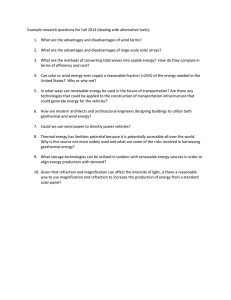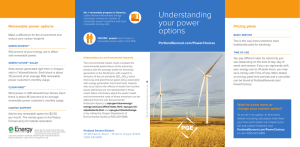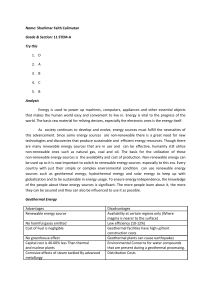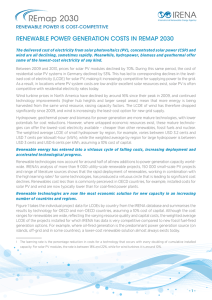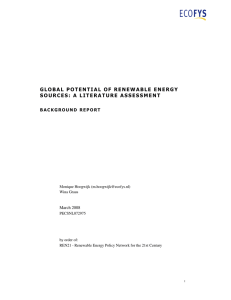Forces Driving Wind Power Development Pat Walsh UW-Madison/Extension
advertisement
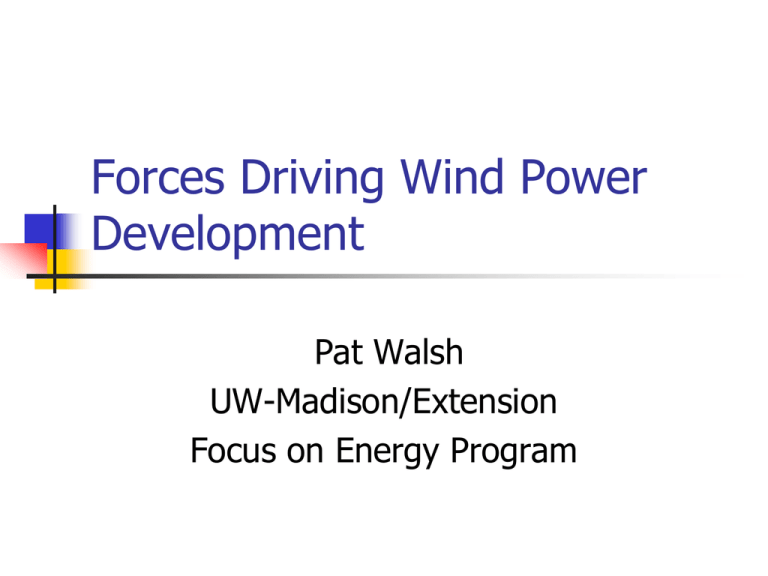
Forces Driving Wind Power Development Pat Walsh UW-Madison/Extension Focus on Energy Program Drivers for Wind Power Fuel Price Uncertainty Energy Security Federal and State Policies Economic Development Green Power Declining Wind Costs US Escalating Energy Use CHINA RECENT ENERGY FACTS China accounts for at least 40% of the growth in global oil demand. In 2004 China will use 830,000 barrels a day more than last year which is about a third of world demand growth, which may soon be fifty percent. Chinese energy consumption will more than double in the next twenty years. Source: US Energy Information Administration Energy Security Issues Are Growing Three quarters of the world’s known petroleum reserves are in the Middle East Most of these are in three countries Saudi Arabia Iran Iraq Natural Gas Source: Community Office of Resource Efficiency Natural Gas Price Volatility Carbon Growth Highest in Developing Countries Emissions Growth GT/yr (1990-2020) Annual Carbon Emissions GT 4 10 Industrialized 25% Industrialized 8 Res/Comm 4% Industrial 22% 3 0.8% Transport 27% 0.7% 6 2 1.2% 4 Developing 75% 2.4% Ind. 2.3% 2 Developing 2.2% Dev. 0 Developing 1990 50% Share 1 2000 52 2010 56 2020 60 0 Economies Sectors Power Generation 47% Shrinking Polar Ice Extent of Arctic summer ice in 1979 (top satellite image) and in 2003 (lower satellite image). NASA photograph The Energy Policy Act of 2005 Public Law 109-58 Renewable Depreciation Deductions Businesses can recover investments in solar, wind and geothermal property through depreciation deductions under the Modified Accelerated Cost-Recovery System (MACRS) For solar, wind and geothermal property placed in service after 1986, the terms are five years. Renewable Electricity Production Tax Credit Provides a business tax credit of 1.5 cents/kWh, adjusted annually for inflation, for electricity generated by wind, closed-loop biomass and geothermal (1.9 cents/kWh adjusted for 2005) Electricity generated from open-loop biomass, small irrigation hydroelectric, landfill gas, municipal solid waste resources and hydropower receive half that rate (currently 0.9 cents/kWh). Available through December 31, 2007 for Renewable Energy Production Incentive New qualifying renewable energy generation facilities eligible for annual incentive payments of 1.5 cents/kWh for the first 10 years of operation. Qualifying facilities must use Solar Wind Geothermal Biomass Landfill gas Livestock refuse Ocean generation technologies (tidal, wave, current and thermal) Fuel cells using hydrogen derived from eligible biomass facilities 2005 Wisconsin Act 141 Renewable Portfolio Standard- requires utilities to generate 10% of their power from renewable energy by 2015 Requires state government to use renewable energy 10% by 2007 20% by 2012 Wind Cost of Energy COE (¢/kWh [constant 2000 $]) 12 10 8 Low wind speed sites 6 Bulk Power Competitive Price Band High wind speed sites 4 2 0 1990 1995 2000 2005 2010 2015 2020 Growth of Wind Energy Capacity Worldwide Actual 45000 40000 35000 Projected Jan 2003 Cumulative MW Rest of World Rest of World Rest of World = 2,803 North America North America North America = 5,018 Europe Europe Europe = 21,319 30000 25000 20000 15000 10000 5000 0 90 91 92 93 94 95 96 97 98 99 00 01 02 03 04 05 06 Year Sources: BTM Consult Aps, March 2001 Windpower Monthly, January 2003 Wisconsin Wind Profile Conclusion Many forces driving wind development Some areas of Northwest Wisconsin may be a good places for wind development Now is a good time for communities and citizens to learn about this technology



